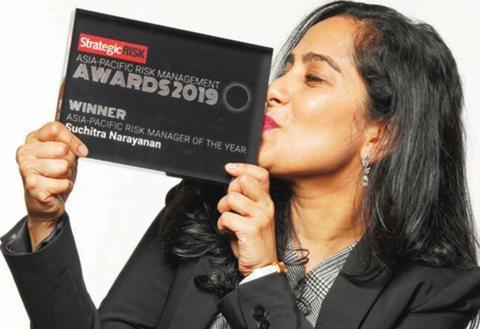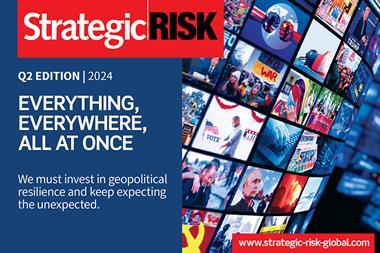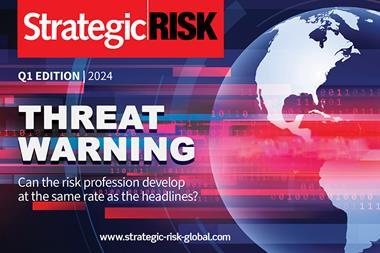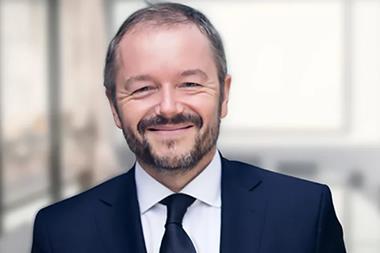For Suchitra Narayanan – accomplished dancer, nimble-footed, creative risk manager, and the 2019 StrategicRISK Awards’ leading lady – risk management is a dance, and being part of changing risk her most captivating performance yet

A highly skilled Bharatanatyam and Odissi dancer, MasterChef contestant, who is highly perspicacious and blessed with a wicked sense of humour, it almost seems like an afterthought to talk about Suchitra Narayanan’s risk management credentials.
And yet, that is precisely why we are here. Narayanan is nothing short of extraordinary. But don’t try to tell her that as you will be met with a self- deprecating eye roll. Her down-to-earth nature makes her someone you want to invite to dinner with your family or maybe a picnic with on the weekend.
Born in Malaysia’s capital, Kuala Lumpur, Narayanan actually then spent the first four years of her life in “deepest, darkest Wales” (to use her words). She laughs as she says: “Can you imagine me with a Welsh accent?”, at least going some way to explain her cut-glass Queen’s English. Her father, a doctor in training at the time, was gathering experience in different environments; something Narayanan has made a point of continuing in her own career.
After moving back to Kuala Lumpur to continue her schooling, she eventually found her way to London to study economics at UCL. When asked if risk management was where she wanted to end up, she says: “No, I thought I would end up a lawyer or more likely, a chef. Definitely not in risk management.”
Why economics? “I felt it was going to give me a pretty broad education without me really knowing what I wanted to do. But when I finished, I took a gap year to dance.” Again, not risk management.
FALLING (ELEGANTLY) INTO RISK
Narayanan is coy when asked why she didn’t take up dancing professionally, quipping “only one in a million make it in the arts”. And so Narayanan took a more predictable path into chartered accounting, where she remained as an auditor for the next three years.
If you are thinking this all sounds a little dull, you are not alone, Narayanan is the first to admit. “I was told it was really sociable but it turns out it is the least sociable job ever and I thought: ‘What am I doing?’” Three years in, Narayanan had had enough of auditing and was looking for a new challenge when along came a risk role in the banking industry.
“It was around 2005 and risk management was just about a term that people were becoming familiar with, but not really. Banking was starting to develop it. So why, and how, did I get into it? By accident,” she laughs. “To be honest, I didn’t know what it was, I just thought: ‘Here’s an opportunity to do something new, figure out what it is that people are doing and why it’s important.’ That was really my grounding in risk management.”
A conversation at a friend’s wedding then led Narayanan back home to Kuala Lumpur; a move she wasn’t sure she was ready for. “To be honest with you, I didn’t know if I was ready to leave London. But I did a little risk management on myself and I thought: ‘Well, if I don’t try it now, then I’m never going to try it.’ It was a great opportunity to take what I’d learned in London and bring that to a new market, and to try to see what people are doing in Asia in terms of risk management.”
GAINING AGILITY IN LONDON
Reflecting on her time in London, Narayanan says thoughtfully: “I was lucky to have cut my risk management teeth in a market like London because you don’t get to be stagnant there. Everything is changing all the time. Whether you like it or not, whether you know it or not, you are naturally going to be part of the #ChangingRisk movement. It is just the way the market is. I think I was probably very lucky to have that grounding, and that education. I was working with the smartest people and I was very lucky to have good mentors and colleagues.”
Narayanan’s grounding in banking and insurance risk management in the fast-paced atmosphere of London also shaped her technical knowledge of risk management; something she has been grateful for in her career. “It definitely gave me strength in terms of technical knowledge but also best practice and really understanding the meaning of agility – as much as I hate that term!” She shakes her head, laughing.
“Things have changed so much within the financial services industry, from rogue traders to the collapse of Lehman Brothers. All of that was in real time for me and it definitely shaped risk management as an industry, but also how risk managers were managing risk. Banking risk management was a great platform for me to understand how risk management can actually be utilised in those situations in the face of abrupt change.”
“Sometimes, people get too caught up in that technical knowledge and then don’t really apply it to real-life situations. So I think it is having that real balance of knowing you’ve got technical knowledge to fall back on, but also being able to adapt it in the right way, to the right situations, that is vital to being a good risk manager. If you’re just going to follow calculations and capital adequacy, then there is a real danger you might miss other more real and pressing issues that might be staring you in the face. It is about just keeping your eyes open and applying common sense and logic to the work that you do.”
GOING MORE FREESTYLE IN KL
Upon moving to Kuala Lumpur, Narayanan says she discovered that the Asian market was not as advanced in its risk management knowledge as London; something she saw as an advantage. “I realised there was still a lot to be done in terms of risk management. It was a blank canvas for me to work with. This was a great opportunity for me in terms of shaping the way I wanted to run the function, rather than it being almost dictated to me by certain set processes and regulations as it did in banking.”
“What that meant for me as a risk manager was a much, much deeper understanding of the business,” she continues. “When you are working in a highly regulated sector such as banking or insurance, there are very set processes and templates that you have to follow without much deviation. But, when you work for an industry that is not as heavily regulated, it’s almost like you have to show people what risk management is about, which also means you have to have such a deep understanding of the business and what they do. Painting that picture for them becomes so much more important. Yes, it has been a challenge, but also an amazing opportunity.”
Narayanan is optimistic about her experiences thus far, musing that despite not actively pursuing a career in the creative arts, her roles in Kuala Lumpur have given her an avenue for creativity she may not have otherwise explored. “These experiences have changed me as a risk manager. I think it has forced me to rethink creatively. Perhaps this is where I am intrinsically creative, even though I didn’t end up pursuing that creative career path. I am constantly having to think of creative ways to devise solutions and talk to people.”
She goes quiet for a minute, then says: “Isn’t it funny how it has ended up catching up with me? It is in a more subtle way, but it has nonetheless. No two days are the same. I am constantly having to talk to different people, think of different ways of doing things and just be really innovative in the way I approach work and solutions to problems. So, as a person, I would say I’ve definitely changed as well. I probably was a bit more rigid in my approach before. Now I’m just a bit more perceptive and I also don’t shy away from embracing change. I’m now almost expecting it to be the norm.”
NO STANDING STILL
Narayanan was one of the original and biggest advocates for StrategicRISK’s #ChangingRisk campaign, believing risk management as an industry has stood still for too long. “I have been lucky enough to work in organisations that have been ahead of their time, which has given me the opportunity to change the way those companies have viewed and executed risk management.”
At the time of our interview, Narayanan was looking for a new opportunity, having recently left AirAsia as their group head of insurance and risk, and changing risk was top of mind.
“My next opportunity has to be a continuation of that story of change. I am looking for an organisation that understands that 2019 is not going to be the same as 2020 and is constantly looking to re-invent themselves, because that’s what is needed in this day and age. I am looking forward to working in an organisation that is progressive and is wanting to take risk management on that journey with them. Even though it’s become a little bit of a cliché, it is still a very relevant sentiment. I don’t think we can rely on our old frameworks and tools to see us through.”
At the time of going to press, Narayanan had secured a new role at one of Asia’s largest e-commerce retailers – an opportunity she later describes as a “natural fit”.
While she is a strong advocate for change, Narayanan is not up for throwing babies out with bathwater in terms of traditional risk management tools, such as risk registers and heat maps. “I don’t think they’re a complete waste of time, because you’ve got to start somewhere. So often that can be a good starting point. It does help to put things in perspective and helps people visualise. So there is definitely some merit there, at least in the very early stages of company risk management.”
She continues: “I think where the problem lies is for risk managers who don’t progress from that. If you are in year five at your firm and you are still updating spreadsheets, I think that’s where it starts being less effective, because you’re not changing things. I’m not saying you’ve got to go in there and change the world immediately, I just think it’s about taking what’s already there, adding what you’ve done and moving it along with the times. That’s really all changing risk is about.”
FOLLOW HER CHOREOGRAPHED FOOTSTEPS
As the winner of StrategicRISK’s Risk Manager of the Year 2019, we asked Narayanan what advice she has for risk managers who are looking to follow in her enviable shoes. “Take stock of where you are,” she says. “Start with where you want to be in three to five years, and then work backwards to see where you are today and how you might achieve your goals. It is about mapping out where you need to get to and being realistic about that. There’s no point changing anything for change’s sake, but you need to know what that destination looks like.”
In mapping your future, Narayanan stresses the importance of working for companies and in roles that mirror your own goals in order to avoid stagnating your career. “Different companies will have very different trajectories. That’s why I don’t believe that you can just take a cookie-cutter approach to risk management and your career. It does not work. It’s about really understanding where you want to be in five years and how that fits into the business model. It’s about understanding not only where you are, but where the company wants to be. Risk management is really driven by what the company needs to achieve and how you’re going to get there. So, if you haven’t woven that into your plans already, you need to start now.”
At this point, we begin to come full circle.
Narayanan shows me the pictures of her dancing that decorate the walls of her parents’ house, where she is residing before moving to Singapore for a new role.
“Come to think of it,” she says, thoughtfully, “risk management is rather like a dance production. You have the vision or a concept of a performance that is basically your strategy or your risk framework. It is the overall concept of what you want to deliver. In order to pull it off, you would need to get people to help you perform this production. It is important to understand what people’s strengths and weaknesses are and how they’re going to work together, as a team, to pull off this production.”
“During rehearsals, which is the grunt work in risk management, you begin to understand how people work together as a team. When you’re on stage, it’s not just about you. It’s about everyone. It’s about how you can all work together to make the best show possible. But it is also about recognising the type of performance people expect to see.”
“Finally comes the performance. All this hard work can sometimes come down to one single moment. In risk management, that is usually a major crisis where suddenly everyone realises what risk management is all about. And that moment when the penny drops is truly magical, because everything just comes together and we can finally see how all these pieces fit together to create this brilliant production.”
It is hard to know where to end this profile because, much like our conversation, it could go on for so much longer. Narayanan’s warmth and passion for life is intoxicating; the more we talk, the more I want to know. The Suchitra Narayanan story is only just getting started. And I can’t wait for act two.




















No comments yet